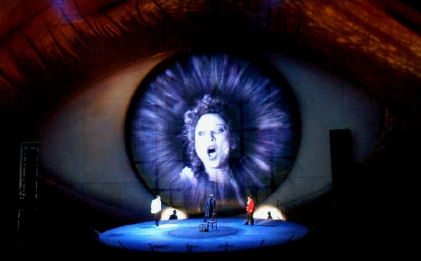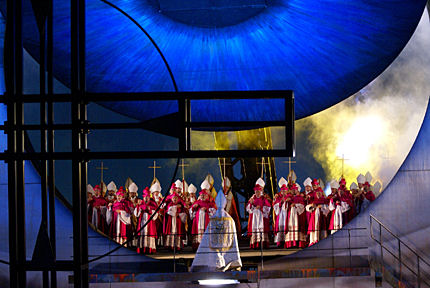|
|
|

Editorial
Board
London Editor:
(London UK)
Melanie
Eskenazi
Regional Editor:
(UK regions and Worldwide)
Bill
Kenny
Webmaster:
Bill
Kenny
Music Web Webmaster:
Len
Mullenger



|
MusicWeb is a
subscription-free site
Clicking Google adverts on our pages helps us keep it that way
Seen
and Heard International Opera Review
Bregenz
Festival 2007: Puccini, Tosca
Spiel auf dem See, Bregenz, Austria 24.7.2007 (JMI)

Last year’s Bregenz experience on the lake was
unforgettable, as we endured a Trovatore
under a downpour that lasted longer than the reign
of Franco! Presenting an outdoor opera seemed
quite impossible as the rain had fallen all day
and even intensified half an hour before the
performance was due to start. In spite of the
meteorological omens however, I had a feeling that
somehow the show would go on as postponing an
opera in Bregenz is a taller order than sinking
the Titanic. It has happened before but only owing
to the most exceptional circumstances. So, clad in
sou’westers and raincoats and carrying paper to
dry our seats, we entered the theatre taking our
places amongst the packed, waterproofed audience.
As incredible as it seems, the rain stopped just
as the performance began, and thus we went from
‘singing in the rain’ to ‘singing in the sweat’.
This year in Bregenz 26 performances of Tosca are
being shown, and at a possible 7000 people per
show, that represents a total audience capacity of
some 180,000. The region itself is too small to be
able to fill that many seats so the audience is
mostly made up of tourists dressed as river
fishermen. On this occasion the honour of being
the highlight of the Festival went to a new
Tosca production by the German Philipp
Himmelmann. Naturally, performances on this
lakeside stage must be both big and spectacular.
If last year Carsen gave us Trovatore in an
oil refinery, this time round we had Tosca
through the eye of Big Brother which dominated the
far end of the stage. With swinging structures,
Johannes Leiacker’s set design is more spectacular
as a work of engineering than of theatre,
especially in the last act.

The first act is soulless and comes only
momentarily to life with the opening of the eye
which offers a very ordinary view of the Te Deum,
a poor quality copy of the Nuria Espert idea in
the Teatro Real’s Tosca. The second act
takes place upon an elevated platform with a total
lack of life as the action has nothing to do with
the opera. The eye opens to reveal Cavaradossi’s
elevated prison in the third act from where he, or
rather his double, is shot and subsequently falls
into the lake to the surprise and admiration of
the holidaymakers. The Tosca duo, with Tosca
outside the prison, like Amneris in the tomb scene
in Aïda is so cold and absurd that it
becomes pathetic.
The costumes by Jorge Jara are contemporary and of
little interest and Davy Cunningham’s lighting is
nothing special. Himmelmann’s scenery design is at
best ordinary, fit only for tourists who expect
nothing more. Sheer boredom.
The music, directed by Ulf Schirmer, was
unbearable. One of the most boring interpretations
I have had to suffer. Apart from the lack of
nuances and inspiration, his funeral tempos only
helped to turn this Tosca into musical torture. I
find myself unable to comment on the Wiener
Symphoniker as the amplified sound, or
should I say the over-amplified sound, totally
disguised any quality the orchestra might have
had. The Bregenzer Festpielchor were nothing to
write home about, affording themselves the luxury
of not coming in on time in the Cantata.
The most interesting vocal interpretation came
from the Armenian singer Karine Babajanyan,
playing Tosca, who caused a
sensation last Spring in Essen as Leonora in La
Forza del Destino. However, it remains
difficult to reach any positive conclusion as to
her performance due to the sound amplification
which is always one of the biggest obstacles in
being able to judge the quality of any vocalist.
The impression is not a bad one, but she would
need to be listened to in other circumstances. She
appears to have a quality voice but was not well
assisted by either of the musical directors.
Compared to the rest of the cast she was
phenomenal, but that often happens. Soltesz has
opted for her again to play Elizabeth in
Tannhäuser next season which would suggest
that she is a quality performer.
The American Brandon Jovanovich is more
Brando than Cavaradossi, which, in fact, says it
all. Good presence but of no vocal interest
whatsoever. Uncontrolled voice, poor vocal range
and devoid of elegance. I’d had the misfortune of
suffering his Cavaradossi before in Burdeos and
this was more of the same, only amplified.
Peter Sidhom, a British baritone of Egyptian
origin, was an unpolished and almost unbearable
Scarpia. An Alberich disguised as Scarpia is only
acceptable for tourists. Then again, I’m also in
that category, so it’s not even good enough for
tourists.
Richard Angas was a deficient Sacristán and a
horrendous Carcelero. Sebastián Soules will not go
down in history as Angelotti.
Adrian Clarke, dire as Sciarone. Hubert Francis, a
weak Spoletta.
Katia Velletaz, passable as Pastorcillo
even though she doesn’t know how to make paper
boats.
There was applause for all from the full house.
Unfortunately I wasn’t able to show my
appreciation as my hands were stuck beneath dense
plastic.
If I am grateful at all to Bregenz it is for
giving me the opportunity from my seat to
contemplate the nightfall over the lake with
Lindau’s port on the opposite shore. Any aesthetic
similarity between the beauty of the landscape and
that of the performance is pure coincidence.
José M. Irurzun
Pictures © Karl Forster
With thanks to Naomi Overney for
translating this review from Spanish (Ed)
Back
to the Top
Back to the Index Page
|
Seen and Heard, one of the longest established live
music review web sites on the Internet, publishes original reviews
of recitals, concerts and opera performances from the UK and internationally.
We update often, and sometimes daily, to bring you fast reviews,
each of which offers a breadth of knowledge and attention to performance
detail that is sometimes difficult for readers to find elsewhere.
Seen and Heard
publishes interviews with musicians, musicologists and directors
which feature both established artists and lesser known performers.
We also feature articles on the classical music industry and we
use other arts media to connect between music and culture in its
widest terms.
Seen and Heard
aims to present the best in new criticism from writers with a radical
viewpoint and welcomes contributions from all nations. If you would
like to find out more email Regional
Editor Bill Kenny. |
|
| |
|
Contributors: Marc
Bridle, Martin Anderson, Patrick Burnson, Frank Cadenhead, Colin
Clarke, Paul Conway, Geoff Diggines, Sarah Dunlop, Evan Dickerson
Melanie Eskenazi (London Editor) Robert J Farr, Abigail Frymann,
Göran Forsling, Simon Hewitt-Jones, Bruce Hodges,Tim Hodgkinson,
Martin Hoyle, Bernard Jacobson, Tristan Jakob-Hoff, Ben Killeen,
Bill Kenny (Regional Editor), Ian Lace, John Leeman, Sue Loder,Jean
Martin, Neil McGowan, Bettina Mara, Robin Mitchell-Boyask, Simon
Morgan, Aline Nassif, Anne Ozorio, Ian Pace, John Phillips,
Jim Pritchard, John Quinn, Peter Quantrill, Alex Russell, Paul
Serotsky, Harvey Steiman, Christopher Thomas, Raymond Walker, John Warnaby,
Hans-Theodor Wolhfahrt, Peter Grahame Woolf (Founder & Emeritus
Editor)
|
Site design: Bill Kenny
2004 |

